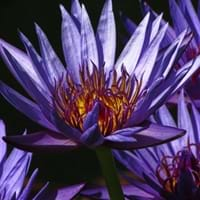Life Span
Annual
Perennial
Origin
South America, Micronesia, New Zealand
Eastern Africa
Types
Not Available
Not Available
Habitat
coastal environs, Grassland, Roadsides, Waste areas, waterways
Lowland, Ponds
USDA Hardiness Zone
7-11
10-11
AHS Heat Zone
11 - 7
Not Available
Sunset Zone
H1, 3a, 3b, 4, 5, 6, 7, 8, 9, 10, 11, 12, 13, 14, 15, 16, 17, 18, 19, 20, 21, 22, 23, 24
Not Available
Habit
Clump-Forming
Oval or Rounded
Flower Color
Purple
Blue, Dark Blue, Yellow, Yellow green
Flower Color Modifier
Bicolor
Bicolor
Fruit Color
Not Available
Light Green
Leaf Color in Spring
Green, Light Green, Dark Green
Dark Green, Green
Leaf Color in Summer
Light Green
Dark Green
Leaf Color in Fall
Green, Light Green, Dark Green
Green, Orange, Yellow
Leaf Color in Winter
Dark Green, Tan
Green
Leaf Shape
Grass like
Broadly Ovate
Plant Season
Spring, Summer, Fall, Winter
Spring, Summer, Fall, Winter
Sunlight
Full Sun
Full Sun, Partial Sun
Type of Soil
Loam
Clay, Loam
The pH of Soil
Acidic, Neutral
Acidic, Neutral, Alkaline
Soil Drainage
Well drained
Average
Bloom Time
Summer, Fall
Early Spring
Tolerances
Drought, Salt
Pollution, Drought, Soil Compaction
Where to Plant?
Ground
In Water, Pot
How to Plant?
Seedlings
Corms or bulbs, From Rhizomes, Seedlings
Plant Maintenance
Medium
Medium
Watering Requirements
Average Water Needs
Plant grows in water
In Summer
Lots of watering
Lots of watering
In Spring
Moderate
Moderate
In Winter
Average Water
Average Water
Soil pH
Acidic, Neutral
Acidic, Neutral, Alkaline
Soil Type
Loam
Clay, Loam
Soil Drainage Capacity
Well drained
Average
Sun Exposure
Full Sun
Full Sun, Partial Sun
Pruning
Remove damaged leaves, Remove dead branches, Remove dead leaves
Remove damaged leaves, Remove dead branches, Remove dead leaves
Fertilizers
All-Purpose Liquid Fertilizer
All-Purpose Liquid Fertilizer
Pests and Diseases
Red blotch
Lily Beetle, Red blotch, Sap-Sucking Insects
Plant Tolerance
Drought
Drought
Flower Petal Number
Single
Single
Foliage Texture
Fine
Not Available
Foliage Sheen
Matte
Glossy
Attracts
Not Available
Aphids, White bugs
Allergy
Itchiness
Diabetes, Nausea
Aesthetic Uses
Showy Purposes
Beautification, Hanging Basket, Showy Purposes
Beauty Benefits
Not Available
Not Available
Edible Uses
Sometimes
Yes
Environmental Uses
Air purification
Air purification
Medicinal Uses
Not Available
Anxiety, Combats Stress, Diarrhea, Improve circulation, increase memory, Soothing and relieving pain
Part of Plant Used
Flowers, Leaves
Leaves, Root, Stem
Other Uses
Animal Feed, Used as Ornamental plant
Oil is used in perfume, soaps, creams, etc., Traditional medicine, Used as Ornamental plant, Used for its medicinal properties
Used As Indoor Plant
No
Yes
Used As Outdoor Plant
Yes
Yes
Garden Design
Cutflower, Dried Flower/Everlasting, Feature Plant, Foundation, Groundcover, Mixed Border, Screening / Wind Break
Bog Garden, Water Gardens
Botanical Name
CORTADERIA jubata
Nymphaea caerulea
Common Name
Purple Pampas Grass
Blue Lotus, Blue Egyptian lotus
In Hindi
Purple pampas grass
ब्लू लोटस
In German
Lila Pampasgras
Blue Lotus
In French
Pourpre herbe de pampa
Blue Lotus
In Spanish
hierba púrpura pampas
Blue Lotus
In Greek
Μωβ γρασίδι παμπάς
Blue Lotus
In Portuguese
grama roxa pampas
Blue Lotus
In Polish
Purpurowy trawa pampasów
Blue Lotus
In Latin
Purpura Pampas herba
Blue Lotus
Phylum
Magnoliophyta
Magnoliophyta
Class
Liliopsida
Magnoliopsida
Family
Poaceae
Nymphaeaceae
Genus
Cortaderia
Nymphaea
Clade
Angiosperms, Commelinids, Monocots
Angiosperms
Tribe
Not Available
Not Available
Subfamily
Not Available
Not Available
Number of Species
Not Available
Not Available
Season and Care of Purple Pampas Grass and Blue Lotus
Season and care of Purple Pampas Grass and Blue Lotus is important to know. While considering everything about Purple Pampas Grass and Blue Lotus Care, growing season is an essential factor. Purple Pampas Grass season is Spring, Summer, Fall and Winter and Blue Lotus season is Spring, Summer, Fall and Winter. The type of soil for Purple Pampas Grass is Loam and for Blue Lotus is Clay, Loam while the PH of soil for Purple Pampas Grass is Acidic, Neutral and for Blue Lotus is Acidic, Neutral, Alkaline.
Purple Pampas Grass and Blue Lotus Physical Information
Purple Pampas Grass and Blue Lotus physical information is very important for comparison. Purple Pampas Grass height is 90.00 cm and width 120.00 cm whereas Blue Lotus height is 80.00 cm and width 40.00 cm. The color specification of Purple Pampas Grass and Blue Lotus are as follows:
Purple Pampas Grass flower color: Purple
Purple Pampas Grass leaf color: Green, Light Green and Dark Green
Blue Lotus flower color: Blue, Dark Blue, Yellow and Yellow green
- Blue Lotus leaf color: Dark Green and Green
Care of Purple Pampas Grass and Blue Lotus
Care of Purple Pampas Grass and Blue Lotus include pruning, fertilizers, watering etc. Purple Pampas Grass pruning is done Remove damaged leaves, Remove dead branches and Remove dead leaves and Blue Lotus pruning is done Remove damaged leaves, Remove dead branches and Remove dead leaves. In summer Purple Pampas Grass needs Lots of watering and in winter, it needs Average Water. Whereas, in summer Blue Lotus needs Lots of watering and in winter, it needs Average Water.





